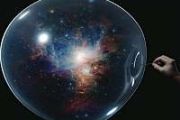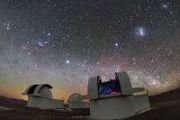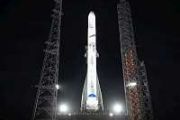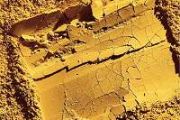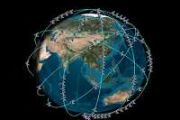
Copernical Team
New evidence suggesting magnetar origin of GRBs
 How gamma-ray bursts (GRBs), the most powerful and spectacular explosions known in the universe since the Big Bang, fuel their high-energy radiations? What kind of physical reactions can trigger and sustain such violent, energetic outflow? This has captivated astronomers. Over the past decades, thousands of GRBs have been observed; however, the origin and the product of the burst - the central c
How gamma-ray bursts (GRBs), the most powerful and spectacular explosions known in the universe since the Big Bang, fuel their high-energy radiations? What kind of physical reactions can trigger and sustain such violent, energetic outflow? This has captivated astronomers. Over the past decades, thousands of GRBs have been observed; however, the origin and the product of the burst - the central c Half of the universe's hydrogen gas, long unaccounted for, has been found
 Astronomers tallying up all the normal matter - stars, galaxies and gas - in the universe today have come up embarrassingly short of the total matter produced in the Big Bang 13.6 billion years ago. In fact, more than half of normal matter - half of the 15% of the universe's matter that is not dark matter - cannot be accounted for in the glowing stars and gas we see.
New measurements, howe
Astronomers tallying up all the normal matter - stars, galaxies and gas - in the universe today have come up embarrassingly short of the total matter produced in the Big Bang 13.6 billion years ago. In fact, more than half of normal matter - half of the 15% of the universe's matter that is not dark matter - cannot be accounted for in the glowing stars and gas we see.
New measurements, howe SwRI analysis reveals exotic nature of TOI-270 d atmosphere
 A new study led by Southwest Research Institute (SwRI) has unveiled a detailed geochemical model of TOI-270 d, an exoplanet roughly midway in size between Earth and Neptune, suggesting it may be a massive rocky world blanketed by an extremely hot and dense atmosphere. Located just 73 light years away, TOI-270 d may serve as a crucial reference point for understanding the vast class of sub-Neptun
A new study led by Southwest Research Institute (SwRI) has unveiled a detailed geochemical model of TOI-270 d, an exoplanet roughly midway in size between Earth and Neptune, suggesting it may be a massive rocky world blanketed by an extremely hot and dense atmosphere. Located just 73 light years away, TOI-270 d may serve as a crucial reference point for understanding the vast class of sub-Neptun SwRI study reveals exotic chemistry of superheated sub-Neptune TOI-270 dwar
 A new study led by the Southwest Research Institute offers groundbreaking insights into TOI-270 d, an exoplanet orbiting 73 light years from Earth. The planet, falling between Earth and Neptune in size, may be a rocky super-Earth cloaked in a dense, scorching atmosphere. Researchers believe TOI-270 d could serve as a key reference point for understanding sub-Neptune exoplanets-a planetary class
A new study led by the Southwest Research Institute offers groundbreaking insights into TOI-270 d, an exoplanet orbiting 73 light years from Earth. The planet, falling between Earth and Neptune in size, may be a rocky super-Earth cloaked in a dense, scorching atmosphere. Researchers believe TOI-270 d could serve as a key reference point for understanding sub-Neptune exoplanets-a planetary class Scientists replicate cosmic light traps using new optical device
 Researchers at the University of Southampton have engineered a groundbreaking optical device that mimics the light-trapping properties of black holes and the theoretical expulsion behavior of white holes, offering an innovative analog to these cosmic entities.
The team based their design on the concept of coherent perfect absorption, enabling the device to either fully absorb or repel ligh
Researchers at the University of Southampton have engineered a groundbreaking optical device that mimics the light-trapping properties of black holes and the theoretical expulsion behavior of white holes, offering an innovative analog to these cosmic entities.
The team based their design on the concept of coherent perfect absorption, enabling the device to either fully absorb or repel ligh AI revolutionizes gravitational wave detector design
 Gravitational waves, the faint tremors in spacetime triggered by cataclysmic cosmic phenomena like black hole collisions and stellar explosions, have opened a groundbreaking observational frontier in astrophysics. But detecting these elusive signals demands precision instruments whose design complexity has long challenged scientists. Now, researchers at the Max Planck Institute for the Science o
Gravitational waves, the faint tremors in spacetime triggered by cataclysmic cosmic phenomena like black hole collisions and stellar explosions, have opened a groundbreaking observational frontier in astrophysics. But detecting these elusive signals demands precision instruments whose design complexity has long challenged scientists. Now, researchers at the Max Planck Institute for the Science o On Jupiter, it's mushballs all the way down
 Imagine a Slushee composed of ammonia and water encased in a hard shell of water ice. Now picture these ice-encrusted slushballs, dubbed "mushballs," raining down like hailstones during a thunderstorm, illuminated by intense flashes of lightning.
Planetary scientists at the University of California, Berkeley, now say that hailstorms of mushballs accompanied by fierce lightning actually exi
Imagine a Slushee composed of ammonia and water encased in a hard shell of water ice. Now picture these ice-encrusted slushballs, dubbed "mushballs," raining down like hailstones during a thunderstorm, illuminated by intense flashes of lightning.
Planetary scientists at the University of California, Berkeley, now say that hailstorms of mushballs accompanied by fierce lightning actually exi Molten core may hold key to Mars' uneven magnetic past
 A new study led by the University of Texas Institute for Geophysics (UTIG) offers a compelling explanation for Mars' puzzling magnetic field distribution, revealing that the planet's ancient magnetism may have originated from a hemispheric field generated by a molten core.
Mars once boasted a global magnetic field strong enough to protect its atmosphere, much like Earth's. Today, that shie
A new study led by the University of Texas Institute for Geophysics (UTIG) offers a compelling explanation for Mars' puzzling magnetic field distribution, revealing that the planet's ancient magnetism may have originated from a hemispheric field generated by a molten core.
Mars once boasted a global magnetic field strong enough to protect its atmosphere, much like Earth's. Today, that shie SwRI-led Lucy probe to pass main belt asteroid Donaldjohanson
 NASA's Lucy spacecraft is preparing for a pivotal encounter on April 20, 2025, as it targets asteroid (52246) Donaldjohanson, a three-mile-wide object located in the main asteroid belt. This flyby, led by the Southwest Research Institute (SwRI), will serve as a rehearsal ahead of Lucy's primary mission: investigating the Trojan asteroids that share Jupiter's orbit.
These ancient Trojan ast
NASA's Lucy spacecraft is preparing for a pivotal encounter on April 20, 2025, as it targets asteroid (52246) Donaldjohanson, a three-mile-wide object located in the main asteroid belt. This flyby, led by the Southwest Research Institute (SwRI), will serve as a rehearsal ahead of Lucy's primary mission: investigating the Trojan asteroids that share Jupiter's orbit.
These ancient Trojan ast Can Solar Wind Make Water on Moon? NASA Experiment Shows Maybe
 Scientists have hypothesized since the 1960s that the Sun is a source of ingredients that form water on the Moon. When a stream of charged particles known as the solar wind smashes into the lunar surface, the idea goes, it triggers a chemical reaction that could make water molecules.
Now, in the most realistic lab simulation of this process yet, NASA-led researchers have confirmed this pre
Scientists have hypothesized since the 1960s that the Sun is a source of ingredients that form water on the Moon. When a stream of charged particles known as the solar wind smashes into the lunar surface, the idea goes, it triggers a chemical reaction that could make water molecules.
Now, in the most realistic lab simulation of this process yet, NASA-led researchers have confirmed this pre 












